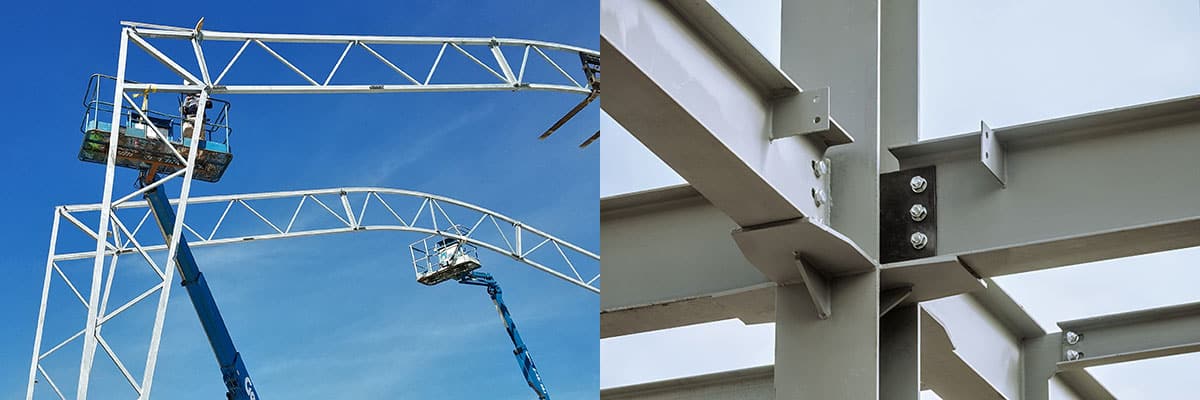Open Web Truss vs. I-Beam Frame: A Technical Comparison
In structural engineering, choosing the appropriate framing system is crucial for the efficiency, cost-effectiveness, and longevity of a project. Two designs are commonly used for tension fabric building steel framing: the Open Web Truss and the I-Beam Frame. In this comparison, we explore the characteristics, advantages, and applications of these two framing systems.
Structural Efficiency
Open Web Truss
Design
Composed of a series of interconnected triangles, the open web truss efficiently distributes loads through its web configuration.
Weight
Lighter than I-beams due to the voids within the web, reducing the overall dead load on the structure.
Material Use
Uses less material for the same span compared to I-beams, thanks to the efficient load distribution.
Load Distribution
Excellent at handling both point loads and uniformly distributed loads. The design allows for better distribution of stresses and deflection control.
I-Beam Frame
Design
Consists of a vertical web with horizontal flanges at the top and bottom, forming an “I” shape.
Weight
Heavier compared to open web trusses, increasing the dead load on the structure.
Material Use
Requires more material to achieve the same span and load-bearing capacity as open web trusses.
Load Distribution
Good for handling loads but less efficient in stress distribution compared to the triangulated structure of the open web truss.

Versatility and Flexibility
Open Web Truss
Span Capability
An open web truss can span longer distances without intermediate supports, making it ideal for large, clear-span widths.
Integration
Allows for easy integration of mechanical, electrical, and plumbing (MEP) systems within the truss, reducing the need for additional space.
Design Flexibility
Can be customized to suit specific architectural and structural needs, providing greater design flexibility.
I-Beam Frame
Span Capability
Limited span capability compared to open web trusses, often requiring additional supports for longer spans.
Integration
MEP systems often need to be routed around the beams, complicating design and increasing construction costs.
Design Flexibility
Less flexible in customization compared to open web trusses due to its solid web design.
Cost Efficiency
Open Web Truss
Material Cost
Generally lower material costs due to efficient use of materials and lighter weight.
Construction
Easier and faster to install, reducing labor costs and construction time.
Maintenance
Lower maintenance costs due to the durability and efficient load distribution.
I-Beam Frame
Material Cost
Higher material costs due to the need for more steel to achieve the same structural capacity.
Construction
Installation can be more time-consuming and labor-intensive, increasing overall construction costs.
Maintenance
Higher maintenance costs due to the potential for greater wear and tear on the solid web.
Environmental Impact
Open Web Truss
Sustainability
More sustainable due to reduced material use and lighter weight, which lowers the environmental footprint.
Recyclability
Easier to disassemble and recycle at the end of the structure’s lifecycle.
I-Beam Frame
Sustainability
Higher environmental impact due to greater material use and weight.
Recyclability
Can be recycled, but the process may be more complex and less efficient compared to open web trusses.
Applications
Open Web Truss
Ideal Uses
Warehouses, large commercial buildings, sports facilities, and any structure requiring large, unobstructed spaces.
Architectural Appeal
Offers aesthetic advantages with its open design, which can be a design feature in exposed ceiling applications.
I-Beam Frame
Ideal Uses
High-rise buildings, bridges, and structures where vertical load-bearing is more critical than spanning large horizontal distances.
Architectural Appeal
Generally used where the structure is concealed within walls and ceilings.
Conclusion
While both open web trusses and I-beam frames have their applications and advantages, the open web truss system stands out for its structural efficiency, versatility, cost-effectiveness, and reduced environmental impact. The open web truss is often the superior choice for projects requiring long spans, ease of integration with MEP systems, and cost-effective construction.
Learn About Fabric Buildings
The Role of Fabric Buildings in Mission-Critical Data Centers
Data Centers Are Booming—Are You Missing Out on These Lucrative Contracts?
Which Are Better, Company Installation Crews Or Subcontracted Installers?
Open Web Truss vs. I-Beam Frame: A Technical Comparison
How Long Do Fabric Buildings Last?
What Is The Difference Between Fabric Buildings And Fabric Structures?
How Much Will It Cost?
It’s Free To Find Out!
Fill out this form to get a free, no obligation estimate for your project.